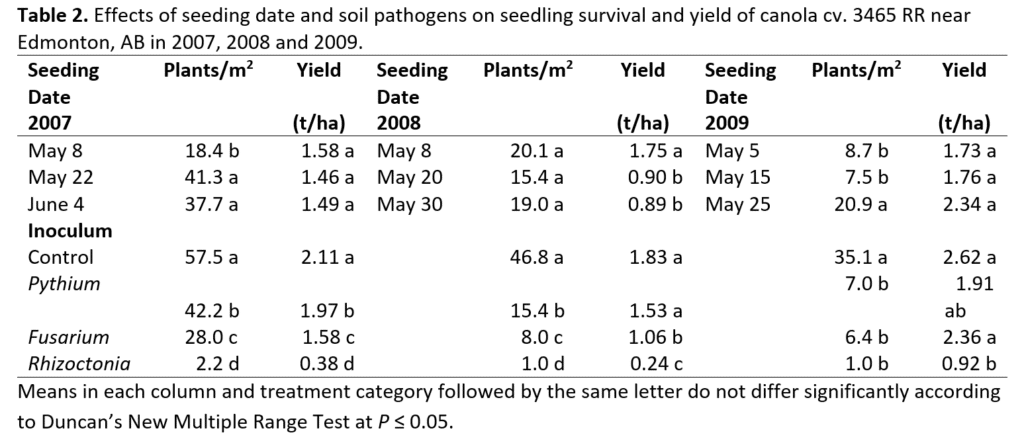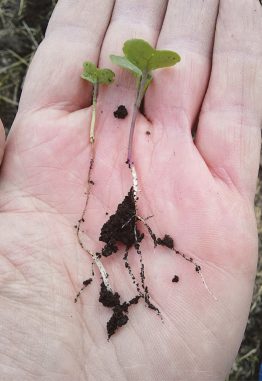Key Result
Lower seedling establishment was associated with earlier seeding in two of three station-years and with canola seeded at greater depths. Some fungicidal seed treatments reduced seedling blight in Rhizoctonia-inoculated soils, while another was more effective in reducing seedling blight in Fusarium-inoculated soils.
Project Summary
Purpose
Observations of inconsistent protection of seedlings by seed protectant fungicides indicate that successful canola establishment continues to be one of the greatest challenges for canola producers in Alberta. Changes in canola production may have caused some fundamental shifts in susceptibility to seedling blight and root rot. Rising seed costs of new cultivars have also made it more important to efficiently achieve target plant populations. This project aims to benefit canola producers, many of whom have suffered severe plant population losses due to root rot and seedling blight in hybrid canola.
Results
A total of 13 fields of canola were surveyed and Fusarium root rot was identified as the predominant pathogen in association with the increased incidence of root rot in hybrid canola crops. Seedling establishment was reduced in plants seeded at the early date in 2007, but not in 2008. Seed ranging from 0.7 – 2 mm in size showed greater yield compared to seed smaller than 0.7 mm. In 2008, seed greater than 0.7 mm in size had greater seedling establishment and yield compared to seed smaller than 0.7 mm.
Seedling establishment decreased with each successive increase in seeding depth although yield was not significantly affected. Delaying harvest resulted in increased viability of canola seed and increased vigour of the resulting seedlings. Dynasty + Helix improved emergence in Rhizoctonia-inoculated plots. In an assessment of seed treatments to control Rhizoctonia seedling blight, Rovral, G 7078 + Rovral, Helix Xtra + Dynasty (1 g/100 kg seed) and Prosper FX resulted in greater emergence and yield compared to the inoculated control. In a separate experiment, treatment with Dynasty + Helix Xtra showed greater emergence and yield compared to plots inoculated with R. solani. Treatment with Rancona resulted in improved emergence in Fusarium-inoculated soils.

Conclusions
This study reported:

- Inoculation with Rhizoctonia solani severely reduced seedling emergence and yield in canola in both greenhouse and field studies. The degree of losses observed after inoculation with this pathogen was greater than for either Fusarium or Pythium.
- This pathogen may be responsible for many of the losses experienced by canola producers.
- Earlier seeding dates have resulted in seedlings germinating into cooler, moister soils.
- Most producers consider the added stress at germination to be offset by reduced stress during reproductive growth (Clayton et al, 2002, Angadi et al., 2004, Kirkland & Johnson 2000). However, earlier seeding modifies the interaction with germinating seedlings with soil microflora (Hwang et al., 2000 a,b) and also influences seedling vigour (Gusta et al. 2004). This study found lower seedling establishment associated with earlier seeding in two of three station-years of field data.
- Lower seedling establishment was observed for seeds that were under 0.7 mm in diameter compared to seeds of a larger size inoculated for Rhizoctonia, Fusarium and Pythium.
- Canola seed planted at greater depth showed reduced establishment in both greenhouse and field studies. Yield was unaffected in the field studies.
- Fungicidal seed treatment impacts
- Experiments with fungicidal seed treatments showed that Rovral and Dynasty + Helix combinations reduced seedling blight in Rhizoctonia-inoculated soils, while Rancona was more effective in reducing seedling blight in Fusarium-inoculated soils.
- Treatment effects in Fusarium-inoculated soils varied with the concentration of inoculum and also with the cultivar of canola.
Learn more in the resulting publication: The effect of seed size, seed treatment, seeding date and depth on Rhizoctonia seedling blight of canola.
References
Angadi, S.V. et al. 2004. Early seeding improves the sustainability of canola and mustard production on the Canadian semiarid prairie. Can. J. Plant Sci. 84: 705-711.
Clayton, G.W., Harker, K.N., O’Donovan, J.T., Blackshaw, R.E., Dosdall, L.M., Stevenson, F.C, and Ferguson, T. 2002. Fall and spring seeding date effects on herbicide-tolerant canola (Brassica napus L.) cultivars. Can. J. Plant Sci. 84: 419-430.
Gusta, L.V. et al. 2004. Effect of seeding date on canola seed quality and seed vigour. Can. J. Plant Sci. 84: 463-471.
Hwang, S.F. et al. 2000a. Seeding date, temperature, and seed treatment affect pythium seedling blight of field pea. Can J. Plant Pathol. 22: 392-399.
Hwang, S.F. et al. 2000b. Effect of temperature, seeding date, fungicide seed treatment and inoculation with Fusarium avenaceum on seedling survival, root rot severity and yield of lentil. Can. J. Plant Sci. 80: 899–907.
Kirkland, K. J. and Johnson, E. N. 2000. Alternative seeding dates (fall and April) affect Brassica napus canola yield and quality. Can. J. Plant Sci. 80: 713–719.
Knowles, T.C. et al. 1993. Nitrogen nutrition of rain fed winter wheat in tilled and no-till sorghum and wheat residues. Agron. J. 85: 886-893.





